
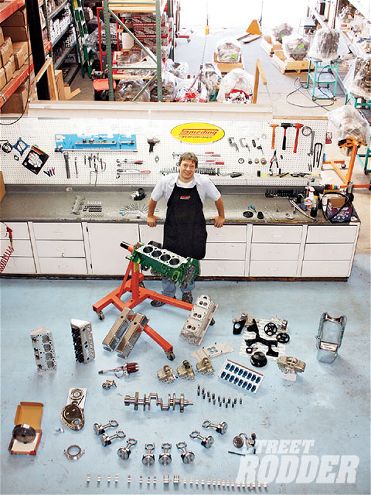
Building an engine requires patience and careful attention to details, even if it's a bone stock rebuild destined for everyday use, but a performance engine is asked to provide its handler with a bit more than that. Thus, the details and the selection of parts going into the package are not just better than cheap rebuild parts, they are all custom-chosen to work together for a specific performance/economy/driveability level. Ben Smeding has been building both stock and racing engines for years, and his experience has led him to accurately predict the exact behavior an engine will exhibit.
Today, Smeding builds only performance engines, and only with brand-new components. He can choose a specific combination of camshaft, compression ratio, cylinder head and valve size, intake manifold, and carburetion to achieve whatever level of grunt is desired, and with the certainty that all these components are matched for the application.
Our '52 Chevy hardtop will be powered by one of Smeding Performance's popular stroker small-block Chevys. Stroker motors make great low-end torque, good for street "gow" in a rod/custom or boat-towing pickup. Smeding offers three versions of the 383-inch, and ours is the middle level of performance, a 400 hp Hot Rod version with 440 lb-feet of torque. The "lowest" 383 he offers still makes 360 hp and 410 lb-ft! His catalog has lots of information on choosing the right Smeding engine for an application, such as idle characteristics, octane requirements, vacuum level, and type of torque converter to match the engine. Every part in his engines is new, and all engines are broken in and tested on his in-house DTS dyno, so he's confident enough in his shop's work that each engine comes with a two-year unlimited warranty.
The Road Tour engine started off like all of Smeding's motors, with a brand-new block and the best of aftermarket components. For the SBC 383s, he uses new GM Performance Parts four-bolt-main blocks that don't need a lot of preparation, as would be the case with a used engine. No rust, no cracks, ideal deck surface and crank bores, and perfectly-clean threaded holes are just some of the advantages of utilizing a new block. They are fitted with one-piece rear main seals and have a 9.025-inch deck height. If you're thinking why not just buy a complete factory crate motor, you could, but you have limited choices of power level, you get some components you may not want, and you don't get the strength advantage of aftermarket forged rods and cranks.
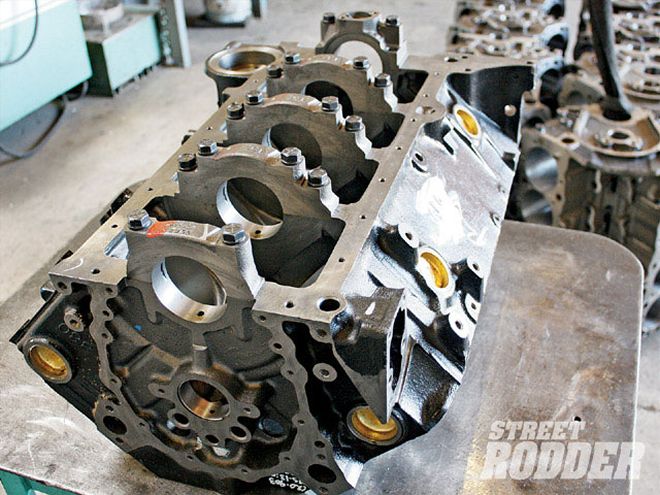
The GMPP blocks require some machine work to be ready for a Smeding engine. He has pistons made for these blocks such that only honing to finished size is required of the bores. The stock GMPP blocks have bores that ranges from 4.00 to 4.002-inch, Smeding hones them to all be the same, and to provide the desired 0.0015-inch piston-to-bore clearance. A stroker crank in a nominally-350 block has a 3.80-inch stroke (0.32-inch more than a stock 350), which means the rods are swinging further out, which usually creates some interference between the block and the rod big-ends and rod bolts. A short session with a die-grinder handled expertly by Dan Moody relieves the block for clearance. The remainder of the block preparation is a thorough cleaning of the block after the honing and clearancing operations. The GMPP blocks come with cam bearings already installed, and in ordinary circumstances the bearings would have to be removed before the cleaning operation, since traditional engine cleaning solutions involve caustic compounds that could damage the bearing coatings. To comply with California regulations, modern cleaning solutions used at Smeding Performance are gentler on the environment and the bearings. The remainder of block preparation is installing the various oil gallery and coolant drain plugs that don't come with a bare block.
The rotating assembly Smeding uses in his 383s is based around a custom 4340 forged steel aftermarket crankshaft that features radiused and polished journals and chamfered oil holes. Swinging around that are hypereutectic pistons (stronger than cast pistons but can be run with tighter clearances than forged pistons), and these are treated to a graphite anti-friction coating on the skirts. For this level of 383, the compression ratio is a perfectly streetable, pump-gas-friendly 9.2:1. Betwixt piston and crankshaft are aftermarket 5.7-inch, 5140 forged steel rods of I-beam design with stout 3/8-inch ARP Wave-Loc rod bolts. Ring choice is low-friction, single-moly type, and the piston pins are full-floating. Seemingly little things like these friction-reducing elements add up to both horsepower and engine longevity. The reciprocating and rotating assembly is also fitted with a new flexplate/flywheel and a new performance balancer.
Dan is the wizard of the Hines digital balancing machine, and after weighing the rods and pistons and making them all the same weight, he comes up with a bobweight to add to the crankshaft before spinning it up for a precision balancing. If weight needs to be removed from a counterweight, a drill fixture is part of the balancing machine setup. If weight needs to be added somewhere, he drills, then installs "heavy metal" (not Iron Maiden; Ben doesn't allow that on the shop sound system). Production engines are factory balanced, of course, but to a lesser degree than what is achieved in a performance engine shop. Most stock engines are smooth enough for everyday driving, but for higher-revving performance applications like our 383, a little bit of imbalance can contribute to uneven wear and slightly less performance. The goal on a hot rod engine is to have all the cylinders operate equally, with the correct timing, fuel distribution, compression, ring seal, and friction loads, and achieving that requires minor tweaking in many areas to "blueprint" the engine. As any old racer will tell you, it's hard to find one new part that makes a 40-horsepower difference from the other guy's motor, but you may find 10 places you can pick up four horses if you study the engine long enough.
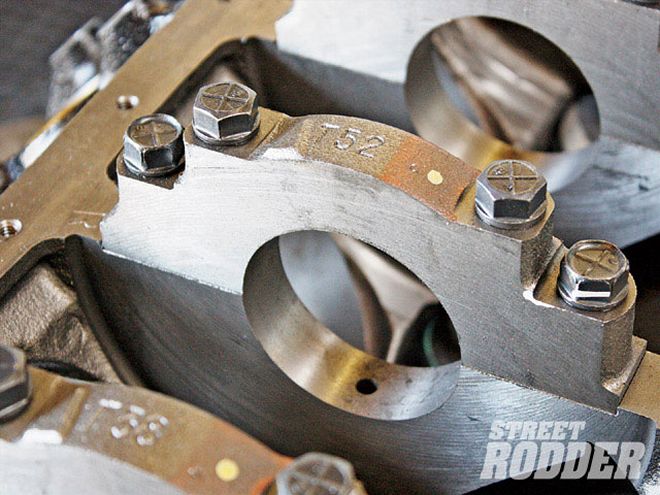 Beefy main webs and caps guarantee that even the highest level of SP 383s will endure in a performance application.
Beefy main webs and caps guarantee that even the highest level of SP 383s will endure in a performance application.
Engine assembly is relatively straightforward on any engine, but careful attention to small details and double-checking all clearances is required, even if you've assembled dozens of engines like it before. The major clearances to check are the piston-to-bore measurement, ring end-gaps, crankshaft main bearing clearances, crankshaft rod clearances (bearings and side clearance at the crank throws), crankshaft endplay and valve-to-piston clearance. The latter is normally checked only when a new combination of piston dome and or cam profile is being tried. Smeding knows his engine combos and their components inside and out, so camshaft degreeing or claying the tops of the pistons to check valve-to-piston clearance wasn't required on our Road Tour 383.
The tailoring of an engine to suit a particular need is in the choices of compression ratio, cam timing, intake manifold/carburetion, and the cylinder heads. A 350 cubic-inch Chevy can be built to make anywhere from 250 hp to 550 hp, all dependent on the way these critical components are matched. Big race heads can't develop their potential without the proper cam, and even with the right cam the engine needs the proper carburetion, too.
At Smeding Performance, they have developed combos that result in rugged engines that fit purposes from mild to wild. Our Hot Rod 383 is fitted with a hydraulic roller cam (another source of reduced friction) ground to Smeding's specifications of .501-inch/.508-inch lift, and 222/228duration @.050-inch lift. That will work with our 9.2:1 pistons to give us a flat torque curve, great top end, and yet exhibit a streetable idle.
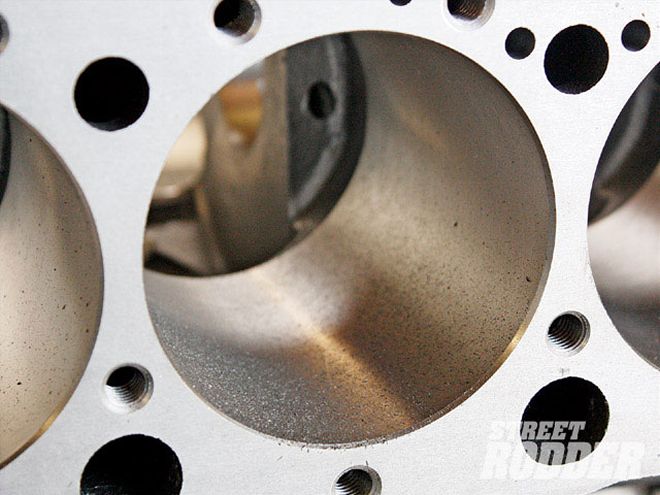 The bores in the new GM blocks have an as-delivered nominal size of 4.000 inches, and only a matter of honing with a torque-plate is required to finish them to the engine builder's needs.
The bores in the new GM blocks have an as-delivered nominal size of 4.000 inches, and only a matter of honing with a torque-plate is required to finish them to the engine builder's needs.
Topping the motor on the all-important intake path are a pair of Edelbrock Performer RPM aluminum heads, equipped with stainless-steel 2.02-inch intake and 1.60-inch exhaust valves. The intake ports have a 175cc volume and the combustion chamber volume specs out at 64cc. Smeding adds full-roller aftermarket aluminum rocker arms, which he likes for their dead-consistent 1.5:1 ratio and another dose of reduced friction for the 383. Stock, stamped-steel rocker arms often vary among a set from 1.44:1 to almost 1.54:1, which might not be noticed at all on a family sedan, but this is a variable less desirable on a true performance engine.
The Smeding 383s are available with a number of optional features, such as polished components, customer-requested oil pans, front covers, flywheels and fuel options such as EFI or dual-quads. However, their standard intake for this engine is an Edelbrock Performer EPS manifold with a custom-calibrated Quick-Fuel 650-cfm, dual-feed four-barrel with vacuum secondaries. This is what was initially installed on our engine and used during the complete break-in cycle of 40 pulls on the Smeding dyno. It's a great combination, but you'll see in another story that Smeding worked with carburetion guru Barry Grant, and we tried some interesting new intakes designed with hot rodders in mind.
All of Smeding's engines are broken in on the dyno, which saves Smeding headaches with customer-caused slipups (like forgetting to put oil in!), and the customer knows his engine has no leaks or noises. With the proper timing and carb adjustments already done, the engine buyer basically just has to hook up the coolant hoses, fuel line, and connect the distributor and starter wires to fire it up in his Camaro, pickup, or street rod. That's what we call plug-and-play!
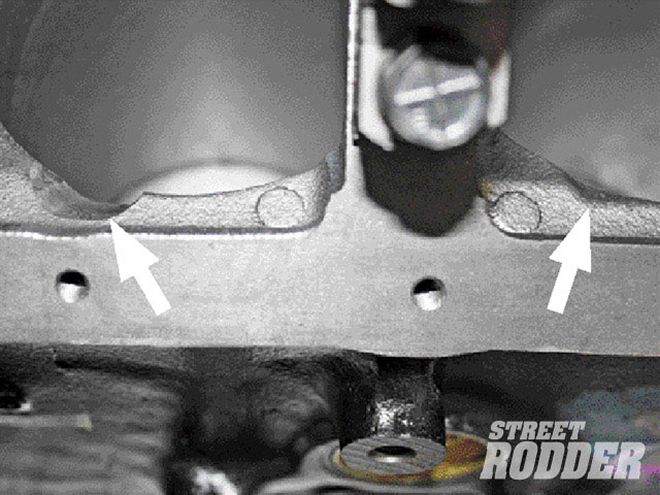 The only other modification to the block is to clearance at the bottom of the cylinder bores for the stroker crank and rods. At right is the indent already provided by GM, at left is where SP technicians have enlarged this with a die-grinder.
The only other modification to the block is to clearance at the bottom of the cylinder bores for the stroker crank and rods. At right is the indent already provided by GM, at left is where SP technicians have enlarged this with a die-grinder.
Our engine was also equipped with Vintage Air's Front Runner accessory drive system, which makes the addition of power steering, alternator and air-conditioning a simple affair. Although our '52 Chevy doesn't have an engine compartment as cramped as, say, a Model A or Deuce, the way these belt-driven components are integrated in the Front Runner system makes the engine look good no matter what the installation. Our bright green engine is sporting shiny aluminum parts all over, like the heads, intake, valve covers, timing cover and even the water pump. Adding the similarly-bright accessories to the front could make our engine look like it was dipped in aluminum, so we chose the black-anodized option for our Front Runner. The billet brackets and mounts look very tasty indeed.
Driveability is a term that is quite subjective. Some rodders are content with a stock engine with a single four-barrel, and maybe a mild cam that is nevertheless designed to produce an idle that just sounds like a radical engine. Others are all over the engine-adventuresome scale, from cool vintage engines to radical big-blocks with blowers, some with powerplants whose top-fueler idle will draw a crowd but scare away women and children. Most of us like "spirited" driving on the open highway, but don't want to be immersed in the reality of city traffic with an engine that doesn't start to run until three grand and can't make enough vacuum to operate the brake booster, or goes off its power curve when cruising with an automatic overdrive.
Even though our engine makes 410 horsepower, more than enough to get us into trouble, piloto-supremo Jerry Dixey's hectic summer pace with the Road Tour Chevy won't have a problem with idle, with the Gearstar overdrive transmission, or with power brakes. Smeding does recommend 89-octane fuel and a mild 2,000-rpm stall converter for use with this engine, but it's very driveable, despite its "medium" idle. No one is going to mistake ours for an auto parts store reman 350. There's enough torque in this one to tow another vehicle and still have some oomph going up hills or passing a few semis on the interstate. Looks, performance and driveability combine in this engine with Smeding's two-year, unlimited-mileage warranty to inspire confidence and a "smile for every mile."